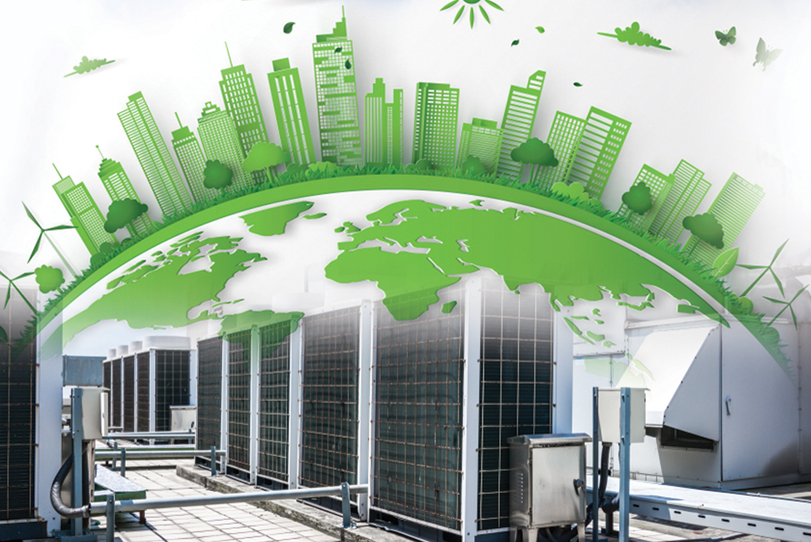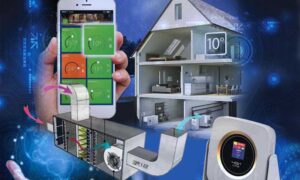Leading experts in a panel discussion deliberated upon HVAC for Green building design concern, IEQ, rating systems and how an integrated move may help mitigate the environmental impacts. HVAC Systems have an important role to play in Green Buildings. Many of the green building factors are affected by the HVAC systems performance.
HVAC accounts for nearly 50-60 percent of the energy used in commercial buildings in India. While designing a green building, the HVAC system should reduce energy consumption and at the same time, it should maintain the interior environment at a comfortable level to preserve the occupant’s health, energy efficiency and productivity. The occupant’s perception is necessary for the indoor environment.
Thermal Control Business Update (TCBU) conducted a conference cum panel discussion recently, on ‘HVAC for Green Buildings’. The participants – Suhaas Mathur, Senior Technical Manager, Green Business Certification Institute Private Limited (GBCI); Mohanprasad Marappan, Head -Strategy, Regional Solutions and Services, Smart Infrastructure, Siemens India; Kushagra Juneja, Managing Partner, Design2Occupancy Services LLP; Surinder Pal Singh, Director, Exalta India and Ashish Rakheja, Managing Partner, AEON Consultants – comprising panel, discussed about green building movement, growth, certifications and opportunities. During the panel discussion they elaborated upon the queries raised as the session moved on. The panellists mostly talked about raising awareness about green building technology through stringent standards and ratings on sustainable architecture and design parameters etc.
Improving health air exchange is universal focus and managing IAQ is a necessity during post pandemic. The pandemic also is in unlocking phase, so, how green business certification levels impact future-built environment in the domain of performance of green buildings?
Any certification provides you with verified performance level – Suhaas replied, stating, if you look at the rating system that we have for existing buildings. If you get a certain level of certification, it signifies that for a particular performance period, your building had air quality which was apt for the health and well-being of occupants. And it is a verification of the success of the sustainability strategies of the facility management team as well. On the design side, any design certification verifies the fact – that your building is ready to administer a healthy space to the occupants. But any design certification must be followed up with right operations and maintenance strategies. It’s this process of continuous improvement and verifying through certification and standard compliance. It’s an ongoing process throughout the building lifecycle. And that’s why we have re-certifications in the existing building certification.
We are adopting many technologies, and still trends are emerging, as always. How challenging are the trends?
Net zero world carbon neutrality is new subject like safe environment, IoT, so how integrating these measures into the green building system will impact environment. Talking about evolving HVAC solutions and that environment is disrupted; Ashish spoke upon energy efficiency around HVAC systems, which are high building factors. He said, trends are not challenging; trends are coming from the fact that there is a requirement. We continue to slaughter the world, the only mother earth that we have; even though we have a green building movement now, which has helped in its own manner, but then that is not adequate, we need to do far more. So, as we continue to do that, the speed of response now has to become more aggressive. The solutions are becoming more aggressive, and this is what we have seen. The jump from the world of energy efficiency alone, or the green buildings alone, now to a net zero has leapt at very fast pace. And net zero is already moving on to the carbon neutrality. It is the ultimate level of sustainability that we would like to reach. The challenges ahead are there, to get through the green building movement. Where we are, it has taken us more than two decades, and still the movement is limited only to the top. The corporate or the big users or the architect world backs engineering world. It has still not gone down to the common person. If you were to ask children or housewives, what is green, I think you’ll get different solutions altogether. So, until it becomes a bottom-up movement, that’s where the challenge will remain. That’s one.
Secondly, the implementation of it, even the tier two and tier three cities, demands speed. Tier-I is not the only solution that we are looking at, we’re looking at Tier-II and Tier-III. Number three, all our focus has been on the buildings, not on a built environment – the system that we need to move to a built environment. And lastly, everything has remained with the designers. The gap between what we design, what we manufacture and how we actually operate remains a big away. So, for operation, bottom-up approach is needed. I think these are challenges which are still there, which need to be addressed to arrive and come to the real solutions.
With the importance of air conditioners, especially in green buildings, what are the suggestions to make air conditioning more energy efficient as well as when it’s used in a green building project?
Surinder responded that you need to make your machines more energy efficient, you can use that by doing the BLDC things and the inverter compressors – that is the only thing which as of now, we can do. Now, the big brands like Voltas or Daikin, they are trying to do it. They have started using BLDC compressors, BLDC Motors, but some companies are still selling those AC they are selling. We need to educate people on that and we as a manufacturer and as a seller, need to work on that, so that we can give people more energy efficient products and these are more sustainable. Normally, AC works for four or five years with compressor because it works on a jerk load, whereas, life of inverter compressor is more. And, sustainability factor also comes there. So, we need to use these kinds of things to make the ACs more energy efficient.
An air conditioner is just one aspect of HVAC solutions available for green building. What other innovations are required in HVAC space for green building projects?
Kushagra deliberated, innovation can be very small, very little, yet it can contribute a lot. Let us take an example of colours, if your interiors are painted white, it will not only give a feel of your space being big, but also at the same time, it reflects light more and you might be able to do the same amount of visual comfort with a smaller number of lights. Also, you can save on the AC energy, which is very small. Let us take an example of VRV systems, but again implementation is very important. This may not provide efficiency, because it is designed for innovation. It has to come in our day to- day routine, our day-to-day operations, the way you can innovate in your building. The technologies are there, but how do we implement them is the thing to consider!
While we talk about technology, whether it is building automation or enhancing efficiency of buildings; what are the suggested measures to convert buildings into performing assets; and are we going carbon neutral by 2030?
Elaborating, Mohanprasad said, Siemens is the first major industry company to comment about going carbon neutral by 2030. What we come with is about the experience, if I apply the same experience here, in the sense that we spoke about a lot of challenges, complexity, how each building is different and about how things are changing. Also at the same time, how do we keep aging of building!
For example, how do I transform an old building into an asset really! Now, while the complexity is growing, the technology is also keeping pace – is what I would say. Today is a time, when we speak about data engineers that we need or about data analysts; these people are very rare in the sense, you don’t get hundreds of data analysts. How do we achieve goal? Can I have a return on investment in three years? That’s the answer which the data can answer and how well the data is based on various project; I am sure that it comes with the expertise, it comes with the technologies. But at the same time, as Ashish earlier said, it comes with a lot of convincing. It’s not that one person can derive a value out of it; everybody needs to think towards that. it’s not a statement of just going green or say for example, getting a certification. Important aspect is an energy project. It is important that how the lifecycle of the project is sustained. So, how do you get the return on investment, how do you measure it! How do you find unit! How do you do a course correction! Is expertise and technology running behind the particular data, then that is the key to the success of any energy efficient building. Also, when we are talking about green building, it is important about sustaining over the decades. It’s not just about the first year of achieving some rating.
Interesting aspects is that we have many buildings, which are definitely not green buildings. And if someone really want to go for it, what is that which takes up the building to a green building. So, what are the concerns from HVAC professionals’ point of view.
Suhaas remarked, let’s say an existing building is not a green building, you can right away start with tracking your performance, that’s the first point of improvement, whether you are green building or not. Your footprint is already existing on the environment, you start tracking your energy consumption, your water consumption, and that those kinds of footprints, start with those things, and improvement on those things, and then move to other aspects such as waste transportation footprint, and that’s where the tools and platform is available for all buildings for free tracking. One can use the tool to track performance on energy, water waste, and human experience for free of cost. So, technologies, enabling performance tracking on a massive scale. There is choice available in the market. All the buildings need to do is they need to be aware, and they need to be proactive, and to start taking action.
Most of the professionals start talking about carbon footprints. People are concerned, about carbon emission, about impact on our surroundings. Even new architects, new engineers explore what kind of projects they need to create to meet emerging challenges.
For, how to look at HVAC from a green building perspective, Ashish mentioned, I think you heard from all of the esteemed speakers on panel, on what the future holds and what they’re seeing. In fact, if you look at what Suhaas started with in terms of how the rating systems are evolving to address the concerns of the built environment, whether it was green rating, which was years back, green itself keeps evolving IEQ, well rating system which is there, and with regard to the COVID how they’re addressing that, so it goes on going forward, I think that becomes a reality you will keep seeing things like this one talking about. But this is where the future is. Our buildings have to talk to us. Because, if the buildings talk to us, we get to know what’s the trend is going on. That’s where we start correcting them. So, performance-based design is something which is going to become a reality as we go forward. Now from my perspective, what I see for the future generations, I think, these are exciting times. If you think you’ve seen big things so far in Indian building industry, I think it’s nothing in the last two decades. We are just the tip of the change that is coming in. Mind it, we continue to play havoc with our mother. The time is running out, as the time is running out, the need for action is becoming faster. Buildings have been identified as a low hanging fruit, what we have done till date is still not adequate. If I go by the number of green buildings that we have in Indian context, I think will not even go into the double digit, the remaining 90 percentage plus is not green.
When you spend a 95-percentage time inside the buildings, you’re expecting buildings to keep you safe. You want buildings to be efficient, buildings will ultimately do what we call energy generation, which is happening, buildings will do water generation, which is happening, in fact, you’re doing the rainwater capturing as human population continues to grow. The building evolution is going to be faster. Today, Living Building Challenge is becoming a reality where the requirement is net zero energy net zero water, zero waste, and five or more things which are there. So, far, we’ve limited ourselves to thinking office buildings, residential buildings, but as you go forward, even the mega projects, like airports, like places of worship, are all looking at similar solutions. And the challenge is how do you keep integrating innovative concepts? How do you make them more beautiful! I think the beautiful is now how do you integrate everything into it! So, I think these are challenging times. These are exciting times and our younger colleagues should be happy about it. And that’s where the HVAC industry role is. We spent much time indoors; we want a better world. We want cleaner world. I think it’s got a great future ahead of us.
Future ahead
Globally, Green building movement concerns climate, and optimum utilisation of natural resources. Its designs provide an integrated approach into construction – that created a need for green building rating systems. Government initiates push to have 200 million sq. metres., of green-certified buildings by 2022. The sustainability in built environment, and energy efficiency is of utmost importance. The building designs techniques, standards and codes by ECBC and ASHRAE help save on energy consumption, automated controls and alert systems. Pandemic now transcending the wave-3, created awareness about health and environment hazards. More so, there is need for structures with low greenhouse gas emissions; virus-repelling buildings and integrating new technologies and energy efficiency around HVAC systems for green buildings. It was aptly pointed during discussion that trends are coming from the fact, that there is a requirement.
Cookie Consent
We use cookies to personalize your experience. By continuing to visit this website you agree to our Terms & Conditions, Privacy Policy and Cookie Policy.















